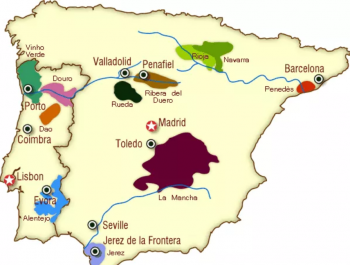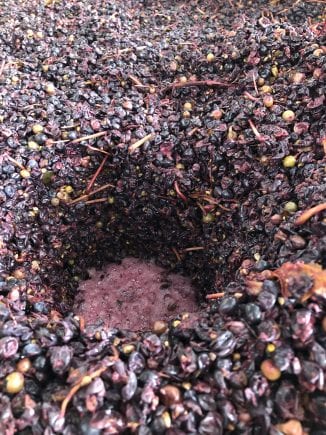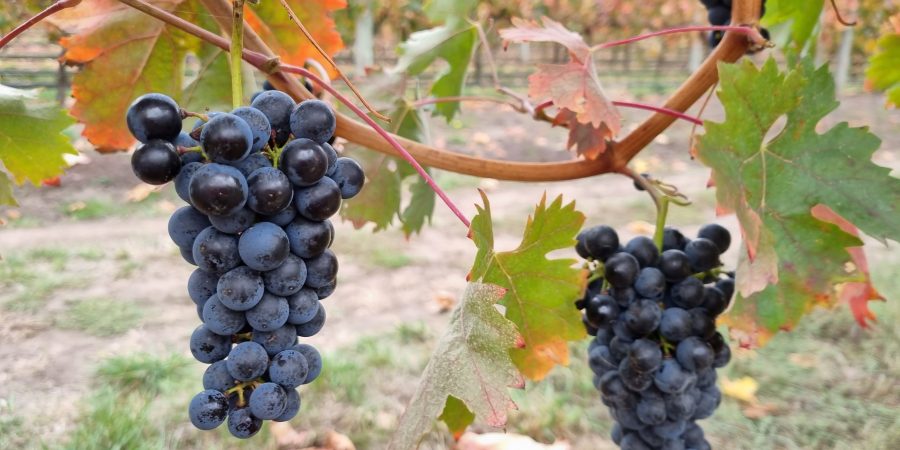Well, that’s a wrap for vintage 2022.
The last of our fruit was picked on Tuesday, by a team of expert pickers (well, they’re experts now!). A huge thanks to everyone who helped out.
Volunteer ages ranged from 5 to almost 80! Fun for the whole family…

So, which variety of grape is (slowly) filling up this bin?

GRACIANO!
 Graciano is a black-skinned variety from Northern Spain. It is mostly grown in the Navarra and Rioja wine regions (those green bits on the right-hand side of the map).
Graciano is a black-skinned variety from Northern Spain. It is mostly grown in the Navarra and Rioja wine regions (those green bits on the right-hand side of the map).
It’s not commonly grown in other parts of the world, although small quantities can be found in California and here in Australia. It is also grown in France under the name Morrastel.
The classic Spanish Graciano wine is moderately tannic, deeply coloured and intensely perfumed. It has aromas of mulberry, violets and chocolate.
Graciano’s intense flavours and aromas make it perfect for blending. In Rioja it is very popular with winemakers who use it to make the classic Rioja blend with Tempranillo and Grenache. Even when it is used in only small volumes, it has a definite influence over the finished product.
Unfortunately, Graciano can be a bit of a pain to grow. The vines are very low-yielding, which is probably the biggest reason growers chose not to plant more of them. They are also particularly susceptible to rot and downy mildew. In the 20th Century, many Rioja wineries uprooted their Graciano vines in favour of more fashionable grapes such as Tempranillo and Cabernet Sauvignon. Happily though, the variety is regaining popularity.
We’ve been growing Graciano in Australia for 100 years. Brown Brothers planted vines in the King Valley (Victoria) in the 1920s. While we still don’t grow a lot of Graciano, it can be found all over South Australia and in Margaret River in Western Australia.
Just like the Spaniards, Rob is planning on blending the Graciano picked this week with some already happily fermenting Tempranillo for his upcoming 2022 Picnic Races Red.
Here in Australia we really love to showcase the characteristic aromas and flavors of straight (unblended) varieties.
So, it begs the question…
Why blend?

Some winemakers and wine experts believe that blending different varieties makes for a lesser wine.
But blending is a pretty tricky thing to do.
It takes several years (if not a lifetime) to master the art of blending. Great winemakers often use a combination of technical analysis and tasting. Some blends go through a process of 50 or more tries until the perfect “recipe” is created.
Also, blending wine is like a lovely combination of science and art. It takes individual pieces to make the sum better than the parts.
Loving our blog? Sign up for weekly updates straight to your inbox…
[withwine type=’join-mailing-list’]
Well-known blends
There are a lot of pretty famous blends out there. Some you may not even immediately think of as blends.
Like Champagne for example. It’s usually a blend of Chardonnay and Pinot Noir (and often Pinot Meunier as well).
And although there has only ever been one official Somerled blend (some of you may remember the 2010 Picnic Races Cabernet Sauvignon/Cabernet Franc blend?), Rob always blends his McLaren Vale Shiraz. He selects fruit from 3 or 4 sites to blend together to make the final product.
I’m not going to list them all, but let’s take a closer look at just one famous blend and why it works so well…
Bordeaux Blend
“Bordeaux Blends” reference the red blends from Bordeaux, France.
It is a mix of…
- Cabernet Sauvignon which adds body, herbal character, and mid-palate texture that finishes on an oaky-note. Overall, the taste profile is big and long.
- Merlot which has slightly more cherry fruit flavors and more refined tannins offset the herbal nature of the Cabernet varieties. It’s more about the mid-palate.
- Cabernet Franc is often blended alongside Merlot to add complex peppery flavors and a more dynamic finish.
- Malbec is all about up-front richness and black fruit flavors. The finish is not as long as Merlot or Cabernet, but it’s just as smooth and lush.
- Petit Verdot adds floral notes and tannin, along with deep colour.
Why do we see specific blends recreated over and over?
Two very good reasons…
- Tradition: Historic wine-producing regions developed wine blends over a long period of time. Classic French blends are today’s benchmarks.
- Climate: What grows together, goes together. Grape varieties that adapt to the same climate generally make good blending partners.
Blending 101
 As I’ve already mentioned… blending wine is tricky business.
As I’ve already mentioned… blending wine is tricky business.
Firstly the winemaker needs to make a decision about WHEN to blend the wine. There are two schools of thought on this…
- Once fermentation is complete and before they are safely tucked away in their barrels to mature.
- Some time down the track once both/all wines have individually finished their maturation in oak barrels.
While there are pros and cons for both, the final decision really is just a personal one. It depends if you would rather work with the wine as a whole, tweaking it along the way so you know exactly what you’re working with. Or, if you would prefer to work with the components separately so you know what they taste like and then figuring out the right combination at the end.
Once winemakers start blending, they pull samples from a selection of barrels, and out come the pipettes and graduated cylinders!
Many winemakers will start by making what is referred to as a ‘base blend,’ which will be the foundation of the wine.
Then it’s a matter of trialing and testing until they get the right mix!
Rob prefers the first method when it comes to blending. For reasons he couldn’t really put into words, he feels like it’s a more seamless transition from winery to bottle. He likes the idea of the wine maturing as a whole.
Although it will be a good couple of years before we get to sample his 2022 version. Rob luckily made a Tempranillo/Graciano blend for his 2020 Picnic Races Red. And thankfully this one will be released soon(ish! Good things come to those who wait!).
Watch this space for more news regarding its imminent arrival!
